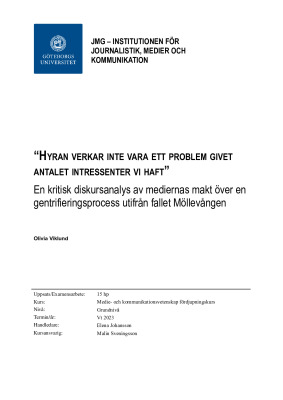“HYRAN VERKAR INTE VARA ETT PROBLEM GIVET ANTALET INTRESSENTER VI HAFT”
En kritisk diskursanalys av mediernas makt över en gentrifieringsprocess utifrån fallet Möllevången
Executive summary
Sweden has gone from having the most regulated housing-market in Europe, to having one of the most liberal and market oriented ones in just 30 years. This has a great impact on the everyday life of the many people living in Sweden’s larger cities. When the state no longer controls the housing-market these people become commodities private companies can make great money off, which result in a class-shift in these areas when people are forced to move out due to increased prices and rents. The term gentrification refers to the change these people
observe due to the shift from the working class to the middle class in urban environments. The gentrification process is as mentioned, characterized by increased market prices and rents, but also by a new identity of the neighborhood in question. Typically a working lifestyle
is replaced by a more creative oriented lifestyle in the area.
This study is based on the case of Möllevången in Malmö which according to researchers is undergoing the third stage of gentrification at the time of writing. About thirty years ago Möllevången was portrayed as a neglected area in the city with a very high problem with criminality in the media. Today the media portrays the area as a place with “a crazy high increase in prices” and creative residences with cozy apartments filled with nice flea market-furniture. The critical eye would start to wonder if there is a link between the media’s portrayal of Möllevången and the gentrification process. The purpose of this study is to, from a critical perspective, examine how Möllevången is portrayed during the third stage of the gentrification process in the Swedish press. And through this examination, identify which discourses and ideologies premetates the Swedish press, regarding Möllevången. The research
questions for this essay is therefore, which discourses are found in the Swedish press regarding Möllevången in a gentrification process during the period 1 october 2022 to 31 march 2023? And secondly, Which ideological beliefs premetates the coverage of Möllevången during the third stage of gentrification?
The theoretical framework for this study is critical theory closely linked to the method used in the study, a critical discourse analysis, focusing on theory about power relations, ideology and discourses. The framework also contains theory about the ideology of neoliberalism in
relation to the media as well as the gentrification process. As mentioned the method used in this study is critical discourse analysis based on Norman Faircloughs model ‘CDA’. The analytical scheme contains eight different analytical dimensions which are applied to the material on which this study is based and are the following. The main content and context of the text, the relation between macro and micro in the text, permeating ideology, discursive practices and strategies, the construction of actors in the text, the use of language in the text, the intertextual relations in the text and at last, the ideologies in the text in a historical context. The material which is used for this analysis are four printed articles from the Swedish newspapers Aftonbladet, Sydsvenskan and Skånska Dagbladet. The articles used were selected based on a strategic selection with the purpose of representing the different types of main content found in the articles discussing Möllevången in a gentrification process during the period of time for this study, in the best possible way. All the articles during the period of time for the study were coded based on their main content and resulted in the following main contents, an outsider is observing the area, a resident or alternatively a previous resident is observing the area, a newly moved in business owner and a business owner moving out.
During the analysis the following results were conducted. The aggregated discourses found in the material were the discourse of Möllevången as poor, the discourse of Möllevången populated by the creative class, the discourse of gentrification as a cause for the loss of
creative places in the area. A discourse of criminality and one of nostalgia and in the majority of the articles, the discourse of the good gentrification. The one ideology which is permeating all of the material is the ideology of neoliberalism. The conclusions drawn from these results
in relation to the research questions for this study are first, that the discourses identified in the Swedish press portray of Möllevången in a gentrification process are the ones mentioned above. Secondly, that the ideology permeating the Swedish press coverage of Möllevången
during the third stage of gentrification is neoliberalism.
The generalizability of these conclusions are based on a theoretical generalizability approach which means that the results conducted in the study should be applicable to a theoretical base as well as to previous research, in order to be generalizable to a different context and to be
credible. Throughout the study, many measures have been taken to demonstrate transparency within the analysis of the material with the hope that the reader will find the conclusions credible. There is also a satisfactory overlap between the conclusions drawn in this study and
those drawn in previous research. Which allows an expanding discussion about the power of the media in relation to this case. The results found in this study also indicate that the media obtains a large power in relation to the legitimation and progress of the gentrification process.

